Key Takeaways From eBikes.org's Report
- Forget electric cars. E-bikes are the leading electric vehicle worldwide and in the U.S.
- Three main factors have contributed to the growth in e-bike sales: the pandemic, economic concerns, and environmental considerations.
- eBikes.org data shows that about 15% of the U.S. population now owns an e-bike, but a lack of awareness and common misconceptions are the biggest barriers to widespread implementation.
- 2024 will bring more diverse e-bike use, from deliveries to increased mobility for senior riders.
- New technology, safety regulations, and improved biking infrastructure will promote increased e-bike use in the coming years.
Riding Toward the Future: Insights Into the Growing E-Bike Market
Electric bikes have surged in popularity over the past years, and if you don’t yet have one, you’ve probably seen quite a few out on the road. However, they aren’t yet making headlines like other electric vehicles — Cybertruck, we’re looking at you.
Even when e-bikes do make national news, it’s not always for the better. Safety has become a significant concern after several lithium battery fires, prompting ongoing security initiatives. As we move into 2024, the question now is whether the e-bike market will continue its growth or begin to plateau due to growing concerns.
To help answer that, we collected extensive data and compiled the insights in our 2023 E-Bike Trends Report. The findings revealed several promising points about the future of e-bike use — and a few hurdles that the market must overcome in the coming years.
Before getting into those details, we want to provide the backdrop for our data-driven predictions by reviewing large-scale electric vehicle (EV) market trends and factors that have spurred recent e-bike growth.
Let’s dive into the nitty-gritty.
E-Bikes: The Silent Leader in the Global EV Transition
If you look at the top EV brands, they’re all passenger vehicle manufacturers. Tesla, BYD, and even newcomers like Porsche are all household brands — and they don’t produce e-bikes.
That, combined with the minimal e-bike market research, might lead you to believe that the recent e-bike boom is just a secondary effect of the global move to electric vehicles.
However, the opposite is true.
E-bikes are silently leading the EV transition. And we’re here to make some noise by both raising awareness and filling in the vast research gaps.
A Peek at the Global EV and E-Bike Market
Global EV sales continue to surge. PwC’s 2023 third-quarter report shows a 28% increase in units sold between September 2022 and 2023. In particular, battery electric vehicle (BEV) sales grew 19% worldwide. This growth pushed the estimated number of EVs sold to 14 million units in 2023.
While impressive, these numbers don’t include e-bikes — and actually pale in comparison to the global e-bike fleet, which boasted an estimated 40 million units in 2023. That’s over 280% bigger than the electric car market.
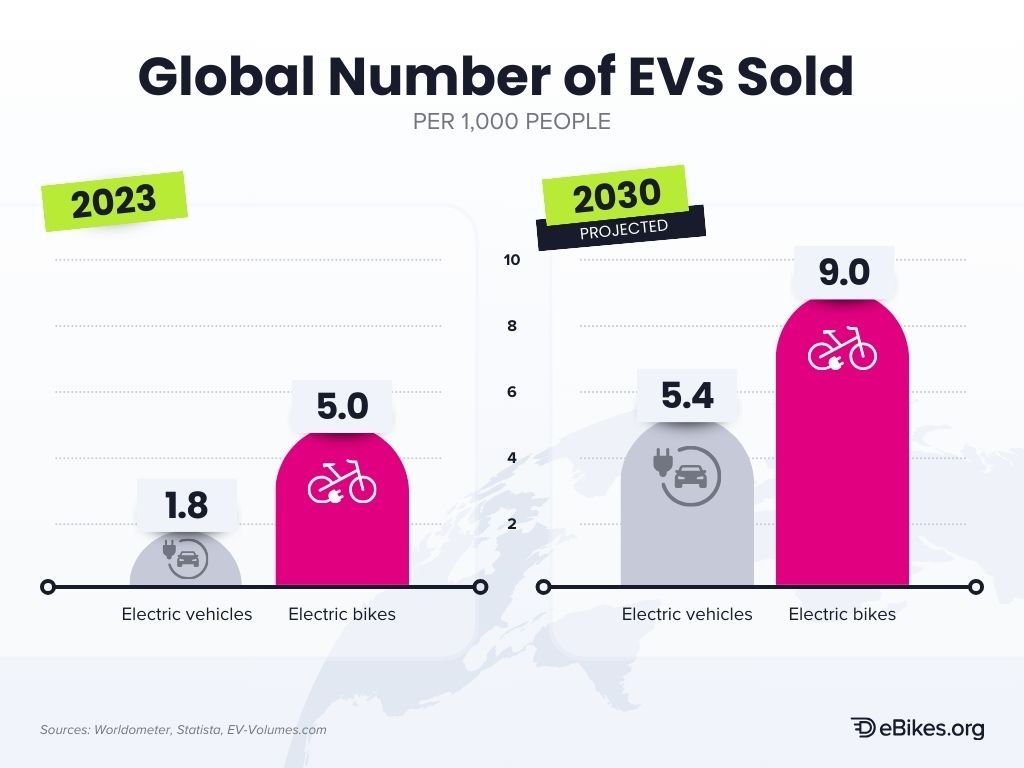
E-bikes have consistently outperformed electric cars, making them the most popular EV.
Granted, nearly all two-wheeled electric vehicle sales occur in China. Notable runner-ups include India, France, Germany, and Italy, where the two-wheeler markets are steadily expanding.
With a projected compound annual growth rate (CAGR) of nearly 10% between 2022 and 2030, the e-bike market is set to maintain its impressive lead over electric cars. We can expect about 44.2 million e-bikes by the end of 2024 and over 77.2 million by 2030.
A Deep Dive Into the U.S. EV and E-Bike Market
The U.S. is home to one of the largest electric car markets, second only to China. With its prominent global position and internationally recognized manufacturers like Tesla, the market is only set to continue its rapid expansion.
This common knowledge only applies to EV passenger vehicles, though. Try bringing up U.S. e-bike brands like Aventon, Xtracycle, or Rad Power Bikes at your next Thanksgiving dinner, and you’ll probably get blank stares.
However, that lack of buzz around e-bikes makes their current success all the more impressive.
According to market research from Circana, U.S. e-bike sales surged 269% from 2019 to 2022, far outperforming traditional bike sales. While certainly remarkable, this data was somewhat expected, given e-bikes’ increased efficiency and performance compared to traditional models. What comes as a surprise is that e-bikes are the most popular EV in the U.S. — and they have been for a few years.
The lack of buzz around e-bikes makes their current success all the more impressive.
Data from the Light Electric Vehicle Association (LEVA) and BloombergNEF show that e-bikes overtook other EVs in 2020 with 42% more imports. The following year saw a massive increase in EVs, but electric two-wheelers still outpaced passenger vehicles with 21% more imports.
Our eBikes.org report also revealed data supporting the idea that e-bikes are rising as silent EV leaders. We found that nearly 15% of the U.S. population owns an e-bike — and often more than one. Looking specifically at residents of major metropolitan areas, the number is a bit lower at 11%. However, that’s still nearly three times the number of people who own electric cars.

About 15% of the population owns at least one e-bike. That's nearly four times the number of people who own an electric vehicle.
We also discovered that people are more willing to invest in an e-bike rather than an electric car. About 17% of our urban respondents were planning to buy an e-bike in 2023, and 47% said they were extremely likely to switch to an e-bike if the tax credit bill passes. That’s a significant jump from the mere 12% seriously considering getting an EV.
Three Factors Driving E-Bike Growth in the U.S.
North America still accounts for less than 1% of the global e-bike market. It will likely take several years — if not decades — for U.S. e-bike sales to be on par with Europe, not to mention Asia.
However, the U.S. e-bike market is quickly gaining momentum. This interest in e-bikes didn’t happen gradually like with electric cars; it largely occurred over the past 3-4 years and shows no signs of stopping.
Let’s explore why e-bikes have quickly taken over electric cars and why the U.S. e-bike market will continue its exponential climb into 2024 and beyond.

1. The Pandemic and the E-Bike
The pandemic played a critical part in mobility evolution, essentially acting as a catalyst for e-bike popularity in the U.S.
Social distancing meant restrictions on public transportation and ride-sharing, leaving people searching for alternative ways to get around. An obvious solution was the bike, not just for commuting but also as a way to exercise during lockdowns. Cities also saw an opportunity for social-distanced transportation and began organizing fleets of e-bikes for public use.
As a result, all bike sales — both traditional and electric — surged in 2020. Conventional bike sales quickly peaked before returning to normal levels, but e-bikes have continued a strong upward streak. After consistently accounting for less than 1% of the U.S. bicycle market, e-bikes passed the 1% mark in 2020. Just two years later, they reached 4% and are expected to continue on an exponential growth trend.
The e-bike sales growth didn’t plateau or taper off as restrictions eased. On the contrary, they continued to grow, showing that e-bikes are here for the long run.
2. The Economic Impact on E-Bike Market Growth
First, let’s acknowledge that, yes, e-bikes are considerably more expensive than traditional bikes. You can find a standard bicycle for a few hundred to a few thousand dollars, while electric bikes generally range from just under $1,000 to well over $10,000.
However, e-bikes are not just a traditional bike alternative, nor do they continually require steep investments. On the contrary, they offer considerable long-term cost savings.
Move Aside, Cars
Thanks to their higher speeds and cargo-carrying capabilities, e-bikes are emerging as a cost-effective car replacement.
The annual cost to charge an e-bike is about $21, nearly 125 times less than what the average American spends on gas in a year.
Not only is the upfront investment considerably lower, but the long-term maintenance is also minimal. According to the Bureau of Labor Statistics, the average American pays $2,635 annually just in gasoline — nearly 125 times what they would need to spend on electricity to charge an e-bike.
Many people are already trying to cut back on travel to save money on gas. In fact, our 2023 eBikes.org report found that almost 31% of people have somewhat or greatly decreased their vehicle usage over the past year due to gas prices.
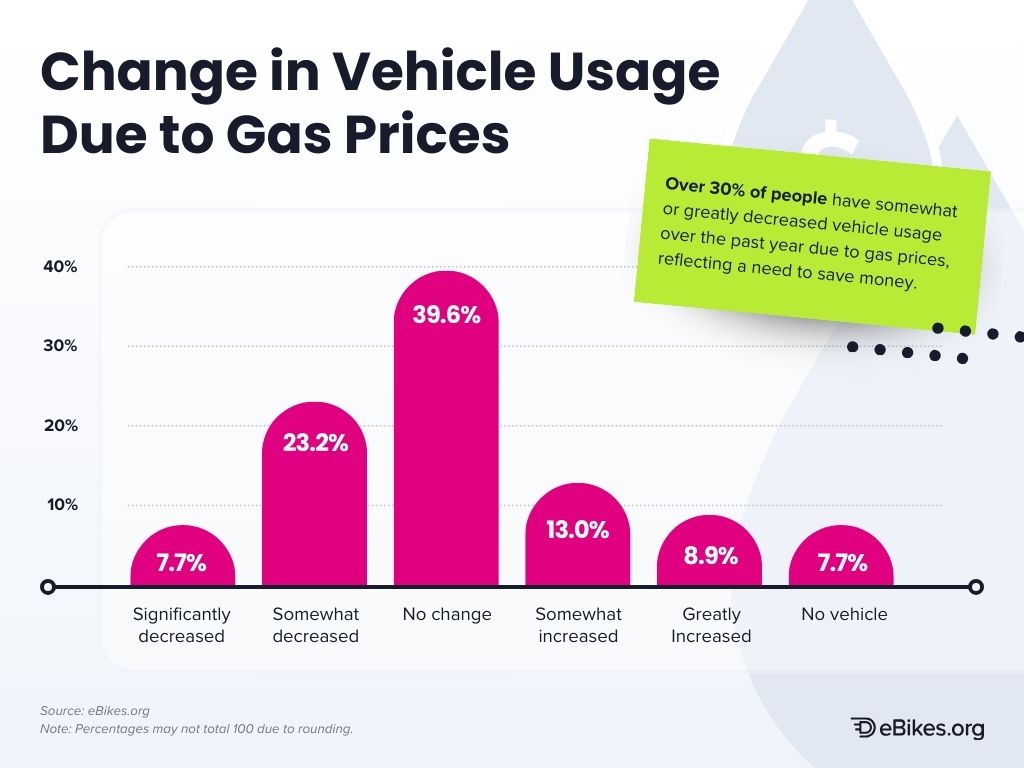
While gas prices dropped during 2023, they remain high. On top of that, the economy has not yet stabilized. Volatility remains, the U.S. GDP is predicted to slow to a near halt in 2024, and experts have mixed opinions on whether the year will bring a recession.
Considering all these factors, cost-saving tactics will remain a priority for many Americans. Eliminating — or at least reducing — those gas expenses with an e-bike could be invaluable.
Bike to Work; Make More Money
Choosing to bike rather than drive can do much more than help people save money — it can also help increase their annual earnings.
In our eBikes.org report, we surveyed over 1,000 commuters and found that bike commuters saved $48 weekly just by not using their cars. This translates to $2,500 annually, which is about how much the average person spends on gas each year.
That cost-saving perk is to be expected. What’s interesting, though, is the substantial increase in motivation and job satisfaction. Our data shows that a significant number of bike commuters have a boost in energy (70%), productivity (27%), and motivation to innovate (40%). Another 30% are less likely to resign.
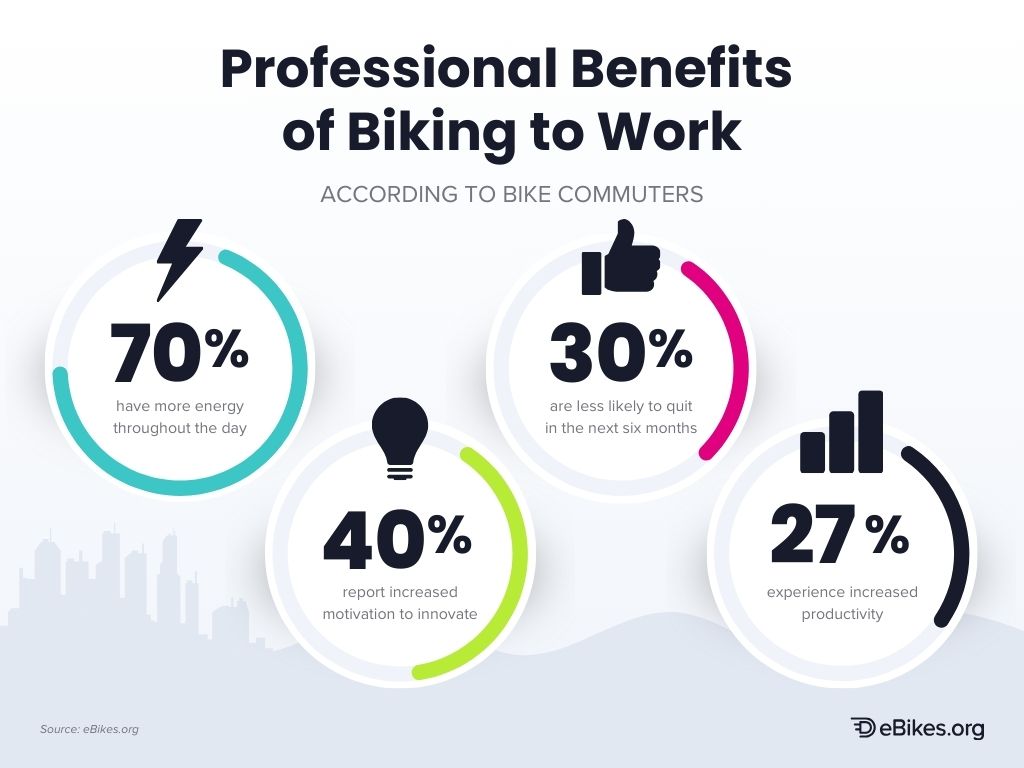
As a result, their job performance improves, leading to higher salaries. This isn’t just speculation. Our eBikes.org report shows that people receive an average salary increase of $5,000 after choosing to bike to work, and bike commuters generally make $15,000 more annually than non-bike commuters.

3. The Environmental Impact on E-Bike Market Growth
The Need for Cleaner Air

This pressing need for cleaner air has impacted residents’ opinions on e-bikes. About 56% of city dwellers believe e-bikes could significantly improve air pollution, and environmental benefits are the number one reason residents would support an e-bike tax credit.
Sustainability as a Leading Purchasing Factor
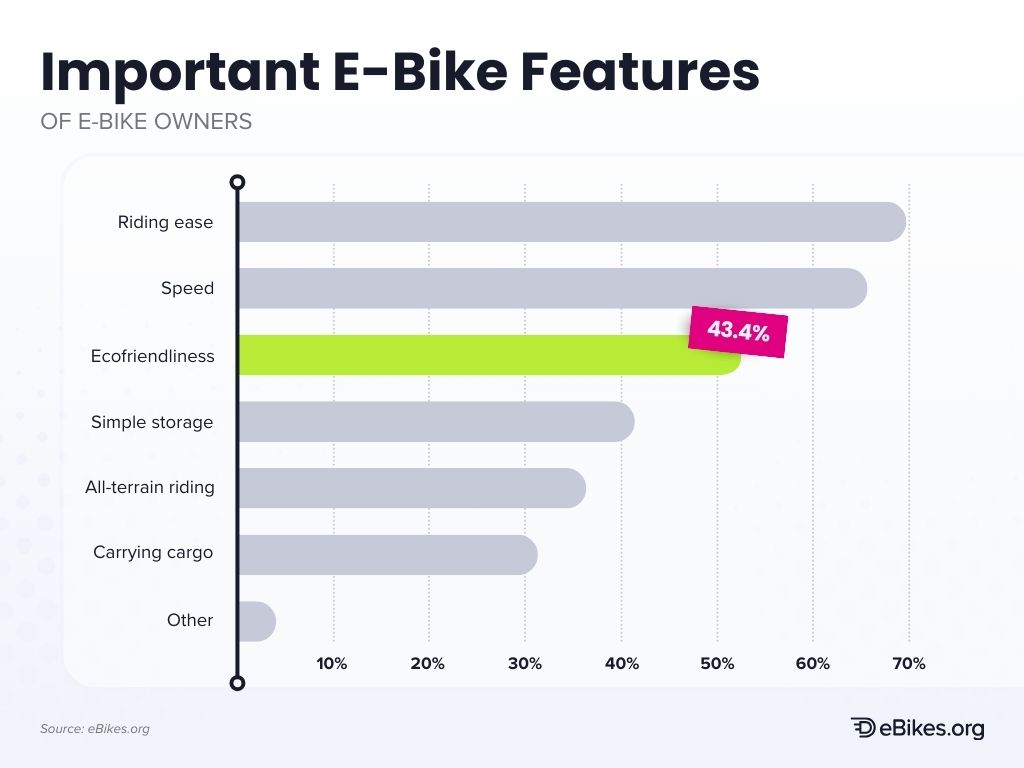
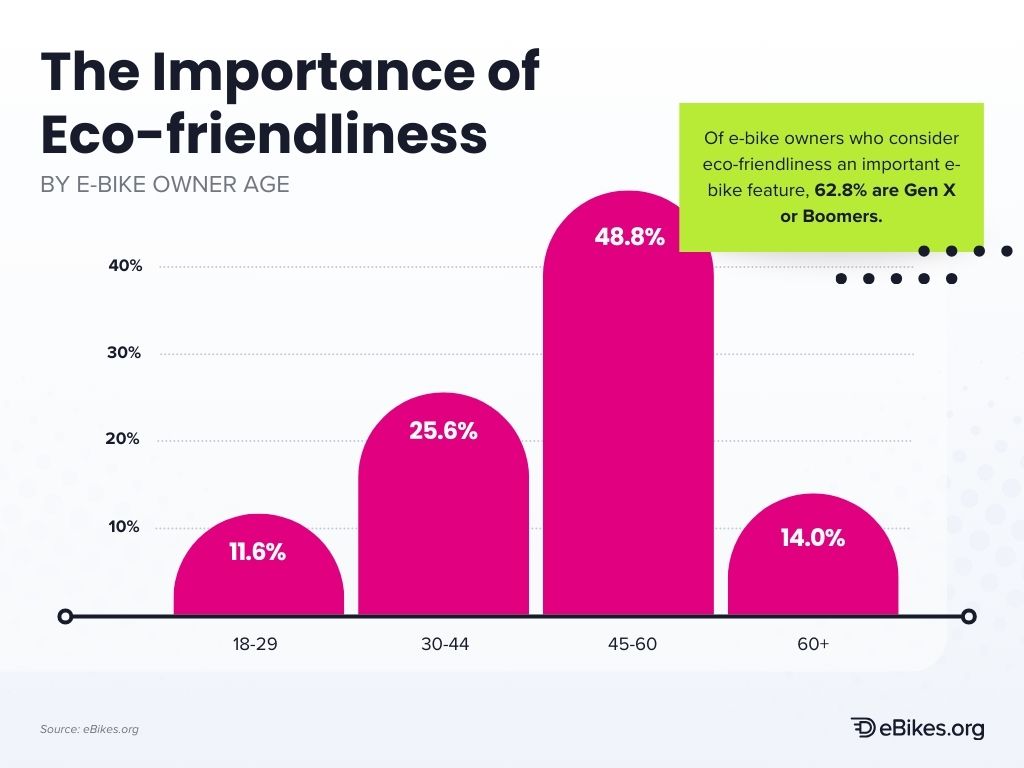
Governments Going Green
What to Expect in 2024
2024 brings new technology, more awareness, and increased diversity to the e-bike market.
Overcoming Unawareness
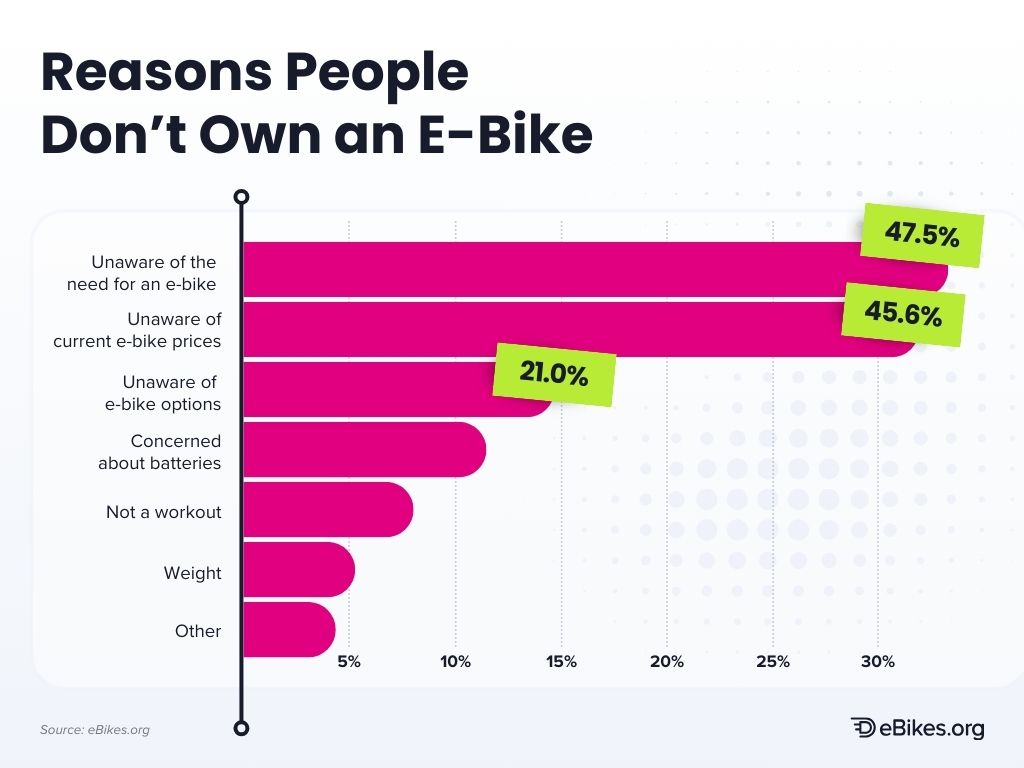
Unawareness of the Need for an E-Bike
Nearly 48% of non-owners said they had no need for an e-bike. While we don’t expect an e-bike to work for everyone, the high number of respondents saying e-bikes are unnecessary speaks more to an unawareness of the benefits than a true lack of need. It could also reflect the limited biking infrastructure, but we’ll explore that later.
There are numerous benefits that people might not be aware of, such as improved road safety, better mobility, and increased sustainability. E-bikes also work for people of all ages and capabilities, especially with the pedal assist features. And there are even kid-sized models so little riders can enjoy trail and urban riding with the family. With that in mind, we could argue that most people do need — or could at least benefit from — an e-bike, if not for their personal benefit, then for the environment.
Unawareness of Current Prices
Another 46% of respondents cited high prices as the reason they have not yet purchased an e-bike, reflecting a similar unfamiliarity with e-bikes.
This concern about price is common with innovative products since new tech usually comes with a high price tag. However, e-bikes don’t cost as much as people think.
High-end e-bikes can cost thousands of dollars, but those are usually for hardcore riders. Plenty of more economical options exist, with some coming in under $1,000. Combine that with the cost savings mentioned above, and e-bikes are an extremely affordable and smart investment. Many owners already realize this. Nearly 40% had a household income under $75,000 — well below the national average of $87,864.

Unawareness of Options
Surprisingly, 21% of respondents said they were either unaware of options or did not know what an e-bike was. This makes sense since other EVs have dominated headlines, and e-bike design is streamlined enough to pass as a traditional bike to the untrained eye.
Welcoming a New E-Bike Era
Despite these hurdles, we expect unawareness to dissipate in the coming years.
Groups like PeopleForBikes are already working to dispel these misconceptions, raise awareness, and change legislation. And here at eBikes.org, we hope to do the same in 2024 by providing more reviews and educational materials.
A lack of awareness about e-bike uses and prices limits widespread adaptation — but we're heading efforts to change that.
With more e-bike riders each year, we expect to see a growing number of people — like you! — sharing e-bike news, advocating for better bike networks, and, overall, improving e-bike awareness.
New Design and Technology
Perhaps the most exciting thing to come in 2024 is new e-bike designs and technology — and there’s quite a bit to unpack.
Several brands have already provided a sneak preview of their 2024 models, getting us hyped up to try these new e-bikes. For example, Bosch announced new-and-improved batteries, additional apps, and an expanded smart system. Simplon has already released a few new models, highlighting their aerodynamic frames and sleek designs that make battery packs almost invisible.
2024 is bringing sleeker, safer, and more environmentally friendly e-bikes.
Sneak Peeks from EUROBIKE
The EUROBIKE 2023 convention highlighted up-and-coming trends, from improved suspension and sleek designs to reinvented cargo racks. Some standout models include the new aerodynamic e-bike from Aero Design Swiss and a rentable Riese & Müller cargo e-bike.
There were also several advancements in sustainability. For instance, Schwalbe’s Green Marathon tire made history as the first bike tire made from other bike tires. Not only does it have a closed-loop product cycle, but it also offers exceptional performance. Deutsche Bahn also unveiled a ‘Call a Bike’ station with a vertical mini garden that improves city aesthetics and air quality.
We probably won’t see all of these advancements reach the U.S. e-bike market this year, especially things like ‘Call a Bike’ or rentable cargo e-bikes. However, we can definitely enjoy the 2024 models and use existing European bike infrastructure as inspiration for ongoing projects.
E-Bike Tech Reveals at CES
The recent CES 2024 in Las Vegas displayed all kinds of cutting-edge technology — but the e-bike innovations stole the show.
Vanpowers released smart e-bikes, complete with an anti-theft protection system, geofencing, an emergency SOS, and other safety features. The best part is that the smart system is available for both urban riders and hardcore mountain bikers.
E-bike brand Urtopia took it a step further with the unveiling of its ‘smartest’ e-bike. The company has incorporated ChatGPT into its e-bikes, allowing riders to receive information about the best routes, review personalized coaching tips, and even have a quick chat while riding.
Artificial intelligence has finally made its way into the e-bike market, and we’re definitely excited to try out these bikes and see how AI can transform the biking experience.
Safety Regulations
Even with continued innovations, safety remains a primary concern for communities. Battery safety is, of course, a priority, but so are road regulations. As more cities roll out bike-share programs and more individuals invest in their own e-bikes, both drivers and bikers must effectively share the road.
Local governments have already implemented some regulations, such as age limits and special license requirements. However, they vary drastically and depend on whether the state views e-bikes as bicycles or motor vehicles. Some states have next to no restrictions.
So, what’s the solution?
We asked both e-bike owners and non-owners what safety initiatives they would prefer to see in 2024, and the top three answers for both groups were safer batteries, required safety gear (e.g., reflective clothing and mirrors), and dedicated e-bike lanes or areas.
The top three e-bike safety initiatives people want to see are safer batteries, required safety gear, and dedicated e-bike lanes.
E-bike owners favored safer batteries far more than other options, while non-owner votes were more evenly distributed. Strict age and speed limits fell in the middle for both groups, leaving rider insurance and license requirements as the clear least favorites.
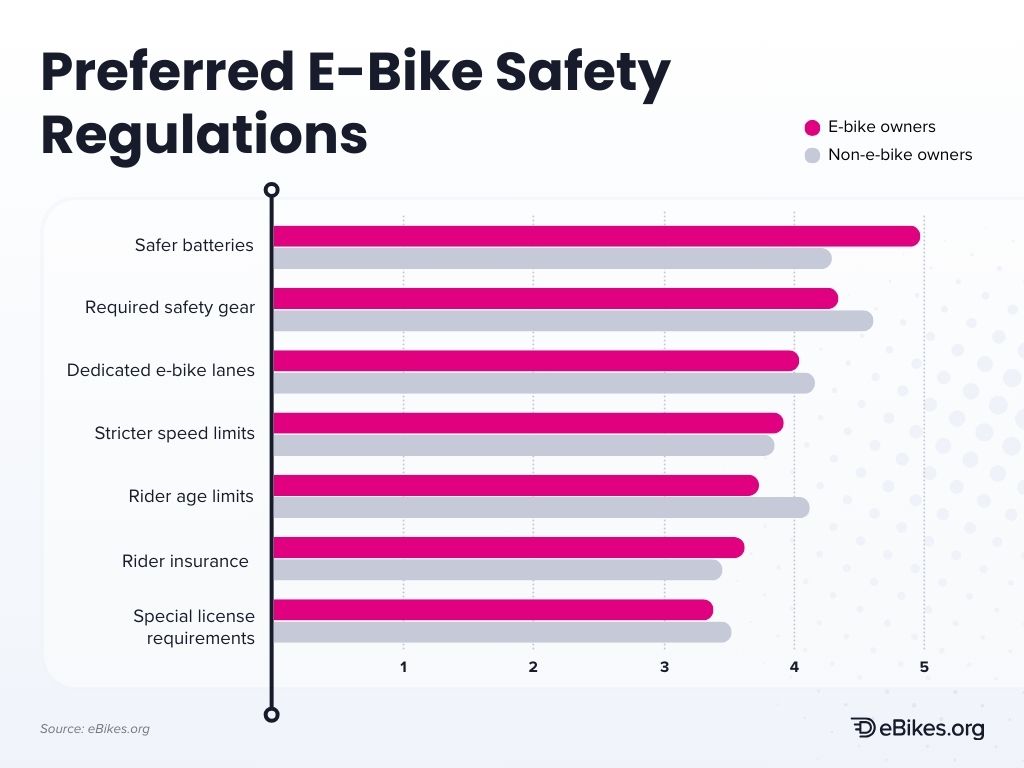
A Step Toward Safer Roads
States like New York are already taking initiatives to prohibit the sale of uncertified lithium batteries. Hopefully, other states will follow suit to keep old, recycled batteries off the market and maybe even implement safety gear regulations. Only time will tell.
What we do know, though, is that local governments will continue to take proactive steps in 2024 to help manage road traffic and safety.
Cities around the world are redesigning their infrastructure to create more bike-friendly environments.
New York City is a prime example. The mayor’s administration recently published a “Charge Safe, Ride Safe” plan to boost electric micromobility and keep riders safe. Starting in early 2024, the city will invest $25 million in charging and storing stations throughout the city. While it doesn’t directly address the issue of safer batteries, it encourages safer charging practices and lowers the fire risk.
Many cities are also addressing the increase in bikers by updating their infrastructure. Some major metropolitan areas like Seattle and Minneapolis have already created bike-friendly infrastructure, while others are still in the process of reimaging the layout.
For example, Dallas recently released an update to its decade-old bike plan after recognizing that the current infrastructure was designed for vehicles, not bikes. With 87% of residents supporting more bike-friendly policies, the city is now preparing for some major overhauls to create a safer and more connected bicycle network.
Change is also occurring worldwide. In 2023, the Bloomberg Initiative for Cycling Infrastructure awarded grants to redesign cycling infrastructure in ten cities, including Fortaleza, Brazil; Addis Ababa, Ethiopia; Lisbon, Portugal; and Wellington, New Zealand.
Diverse Use
Increased Mobility
E-bikes can be a complete game-changer for older adults and people with disabilities.

With more e-bikes designed for adults with limited mobility and growing lists of e-bikes for seniors, this unawareness will slowly dissipate in the coming years.
A Rise in Younger Bikers
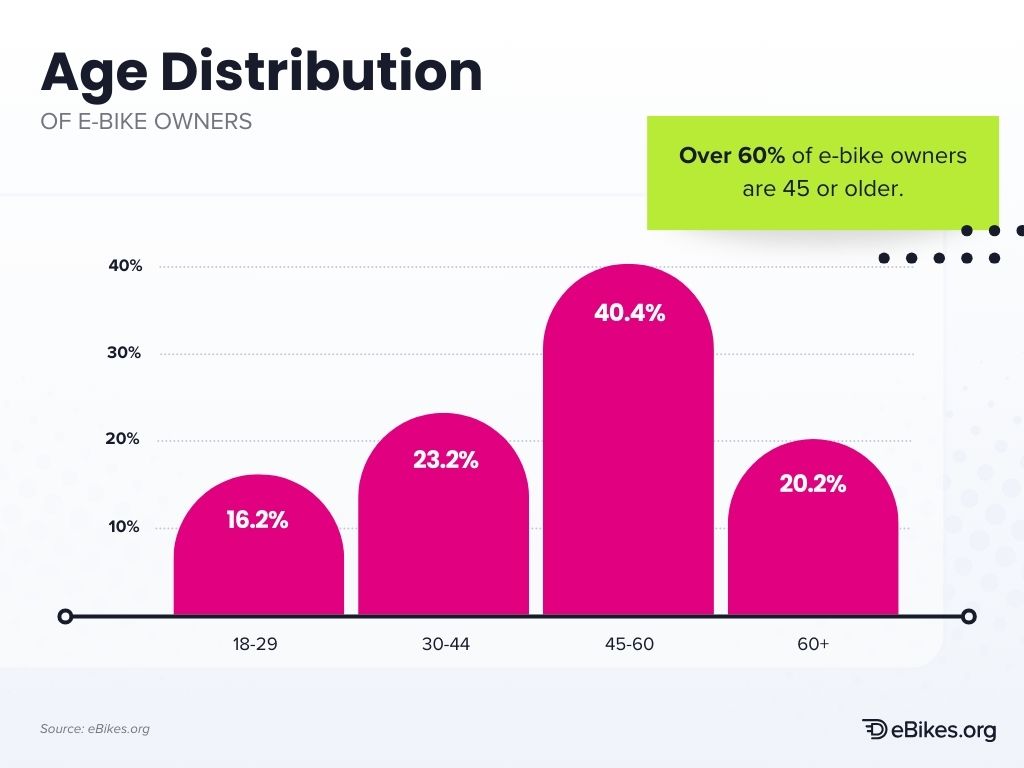
Our survey found that about 61% of e-bike owners are over 45, with only 16% of owners under 30. Most of the younger respondents cited price as the main reason they don’t have an e-bike, which makes sense since nearly half reported a household income under $50,000.

However, this age group was the most willing to consider an e-bike — especially for commuting and urban riding. This openness, combined with an increasing number of affordable e-bikes and a general tech savviness, means we will likely see even more young bikers jump on the e-bike bandwagon in the coming years.
Deliveries
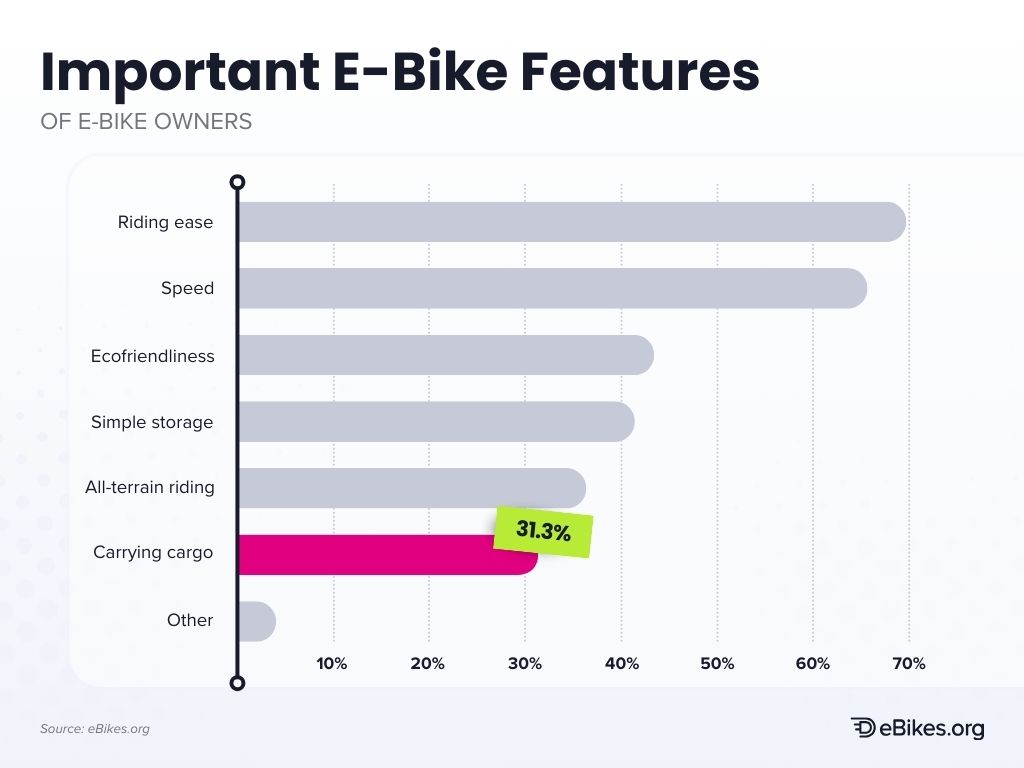
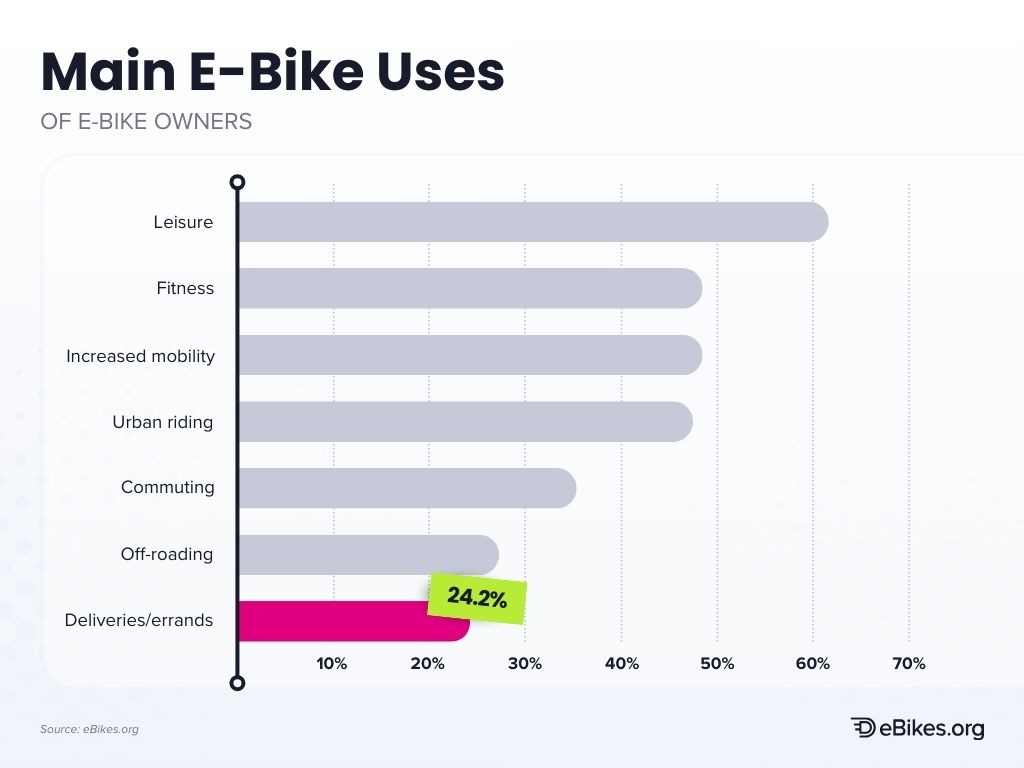
Not only are many e-bikes built to carry deliveries and groceries, but they also have enough motor power to make such transportation easy and sustainable. Delivery e-bikes are already common in other parts of the world, so it’s only a matter of time before they become popular in the U.S.
In fact, many companies are already starting to switch to more eco-friendly transportation methods — like e-bikes — for deliveries. Amazon is a prime example. Its e-bike fleet has helped transform grocery micromobility in New York City, and the company plans to expand its EV-based services in the coming years.
The Everything Bike
Thanks to innovative e-bike designs, we can expect a growing number of multipurpose e-bikes in 2024.
2024 and Beyond
Only time will tell what 2024 has in store for the e-bike market. But if past trends are any indication, e-bikes are on track to have another strong year.
That said, there’s still a lot of work to be done to raise awareness, especially considering how the U.S. e-bike market is almost nonexistent compared to the Asian and European markets. Too many people still don’t know what an e-bike is, let alone that it offers a cost-effective and fun approach to zero-carbon transportation.
So, if you’re an e-bike enthusiast like us, share the word! And if you are just discovering the e-bike world, check out our resources or sign up for our exclusive newsletter.

